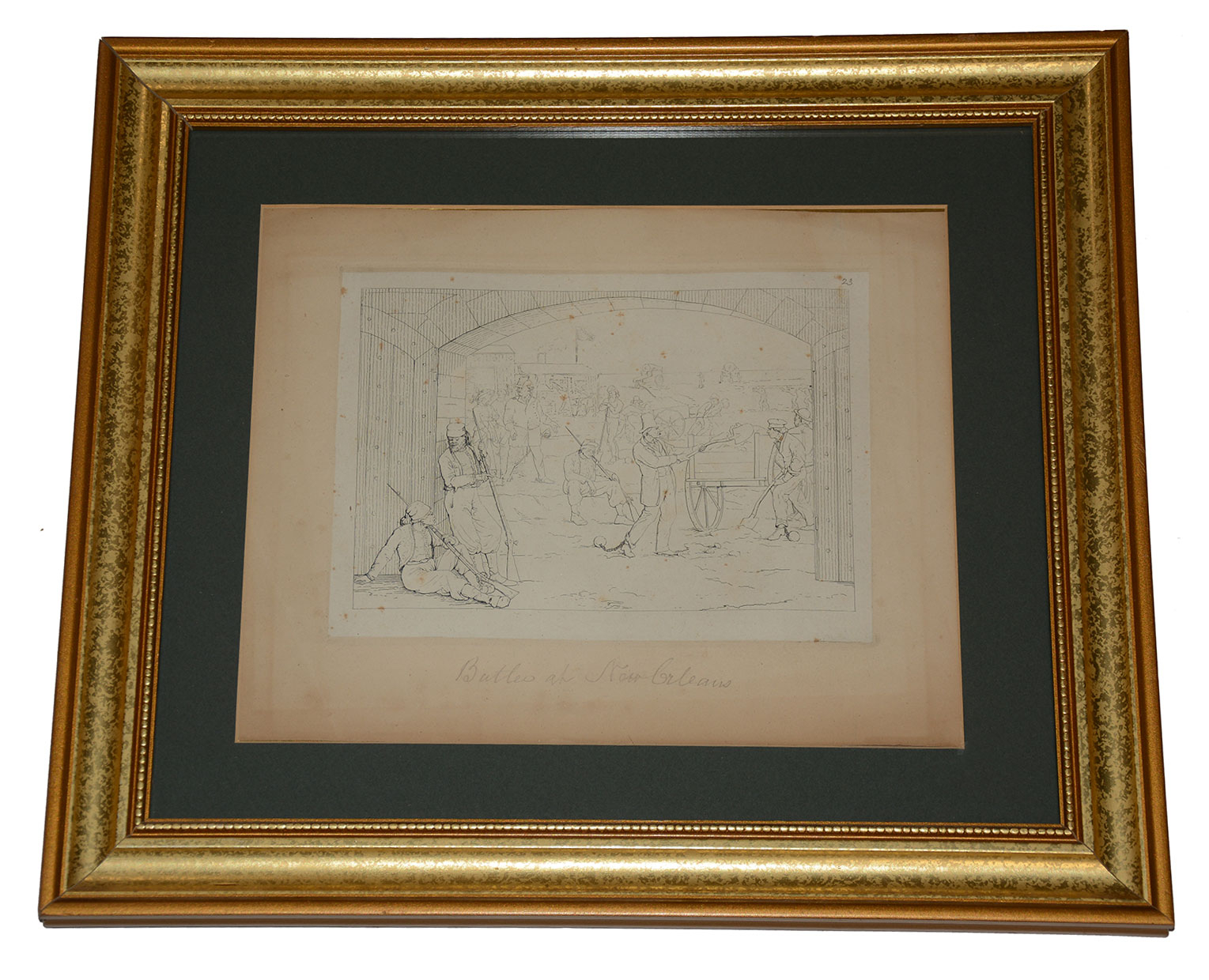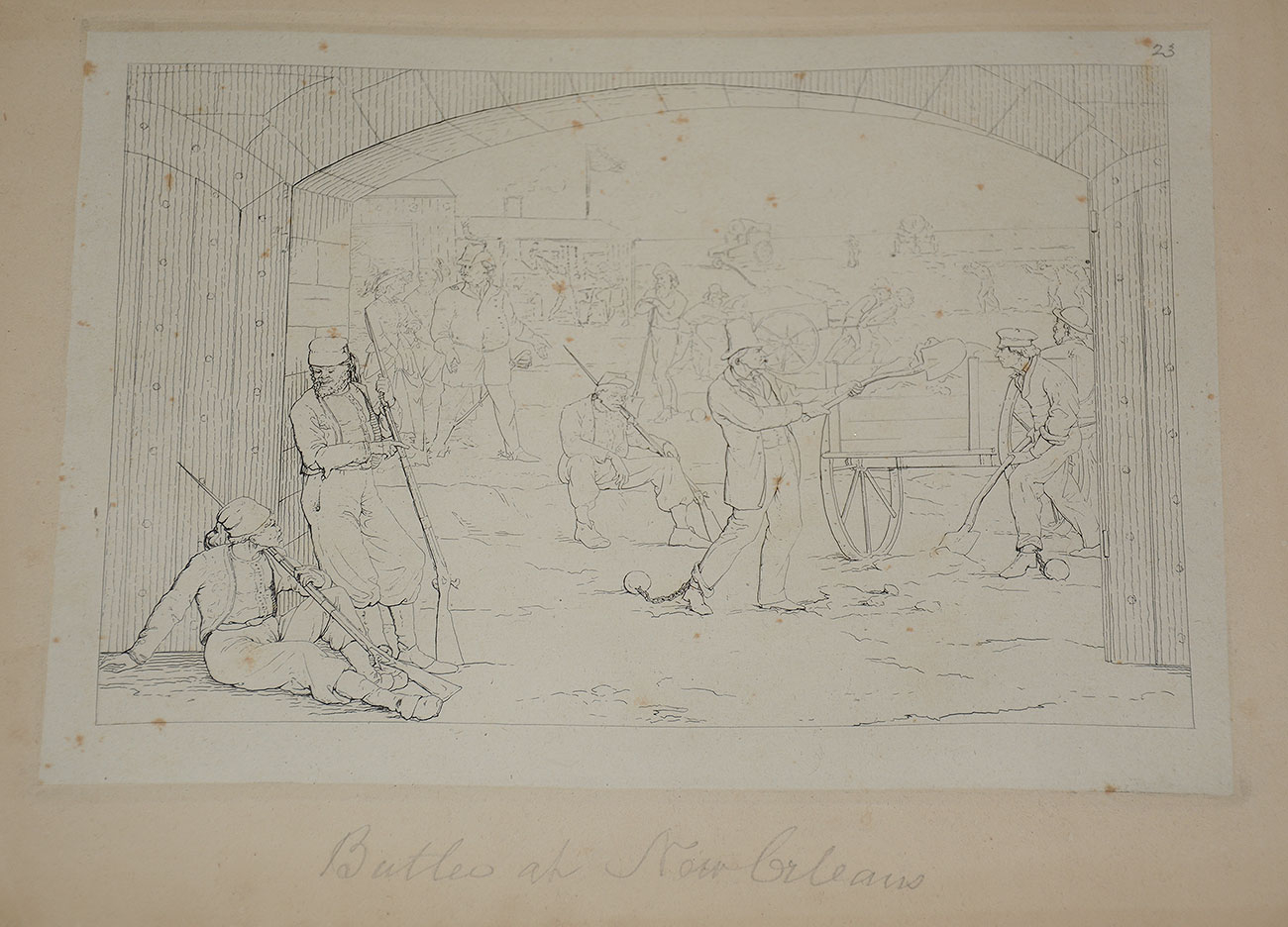site search
online catalog
FRAMED ETCHING: “BUTLER’S VICTIMS OF FORT ST. PHILIP” BY ADELBART VOLCK- “CONFEDERATE WAR ETCHINGS”

Hover to zoom



$125.00
Quantity Available: 1
Item Code: 490-6205
Shipping: Determined by Method & Location of buyer
To Order:
Call 717-334-0347,
Fax 717-334-5016, or E-mail
This is a framed etching by Adelbart Volck, from his “Confederate War Etchings,” originally published in 1863, and has a notation at bottom of the page mount: “Butler at New Orleans,” though the actual title as published was “Butler’s Victims of Fort St. Philip.” Volck was a German refugee who settled in Baltimore and practiced dentistry, but had an artistic bent, very pro-southern sympathies, and a disgust for Gen. Ben Butler in particular as the early military governor of the city.
Volck had gotten into some minor trouble for an early portfolio of twelve satirical sketches of Butler’s doings and lost no interest in the him after he departed for points further south. The view looks into the arched entry way of Fort St. Philip, one of the forts taken in the advance on New Orleans in 1862, and shows a pair of rather churlish looking Union zouaves lounging against the masonry and gate at left while on guard at the entrance with cocked rifles and fixed bayonets, while a slightly drowsy looking guard has seated himself, also with cocked and bayoneted musket, guarding two undoubtedly upright and unjustly detained local citizens busy shoveling manure (well, maybe just dirt) into a cart, discouraged from moving too far from their workplace by a ball and chain around their ankles.
Another civilian has his back to the artist, likely ready to haul the cart away, as two others do in the immediate background, obviously work better done by animals, aided by one fellow pushing. A tall, long-haired, bearded fellow rests briefly on his shovel at center, also wearing a ball and chain. At right in the background, just in front of the far wall of the fort with its cannon mounted “en barbette,” three figures strain under the load of a long beam, and at left two blacksmiths are busy at an anvil, likely hammering out more shackles for the citizenry. At left center is Volck’s nemesis, General Butler himself, somewhat obese and pretentiously uniformed with dress hat, gauntlets, major-general’s coat, spurs and sword, giving a tour to two women, one of whom seems to have her nose rather up in the air and lifts her skirt to avoid soiling it in the muck.
Adelbart Volck (1828-1912) was a German refugee from the failed revolution of 1848. He had a background in chemistry and eventually joined with a Boston dentist in developing a method of using porcelain to fill cavities. In 1851 he taught chemistry at the Baltimore School of Dental Surgery, took a degree there in 1852 as a doctor of dental surgery, and opened a successful practice in the city. He seems to have studied art while in Germany and also at the Maryland Institute College of Art, along with his brother Frederick, who took up sculpture and worked in Virginia during the war. In Baltimore Volck was member of the Allston Association, which promoted culture and the arts, and was decidedly pro-Southern in outlook, being shut down by the military authorities in Baltimore in 1863 for the duration of the war. Both Volck brothers shared those sympathies and Adelbart’s were on display from at least July 1861, when he illustrated an anti-Lincoln flyer. His first substantial production was a series of twelve etchings satirizing Butler, and he also later issued a series of ten “Sketches of the Civil War in North America” and an 1864 series of twenty “War Studies,” issued as lithographs under a pseudonym. A third series was advertised, but never produced.
Volck is often regarded as the southern equivalent of Thomas Nast, but, residing Baltimore, had a much narrower circulation. He did, however, have more bite, progressing from satirical portrayals of figures like Butler to avowedly political, partisan, and pro-Southern caricatures and scenes that contrasted devout southern Christian chivalry with northern degenerate mobs and brutalities, sometimes portraying Lincoln and emancipation in decidedly Satanic terms - being equally over-the-top in his praise and blame. We might notice in this etching the prominent central figure, wearing ball and chain, and leaning somewhat contemplatively on his shovel. With beard and long hair he looks rather like the old-testament figures Volck liked to evoke, as in his portrait Stonewall Jackson in a prayer meeting in camp, the illustration that followed this one (Plates 23 and 24) in Confederate War Etchings.
Volcke thus played a part in the propaganda war by keeping up pro-southern morale and outrage in Baltimore and Maryland, which contributed to the southern cause in men and materiel. He seems to have found his greatest audience, however, in the postwar years when reissue of his work struck a chord in the lore of the Lost Cause, and produced as well portraits of Lee in his college president’s study and in contemplation at Jackson’s grave, etc.
Volck later claimed to have acted as Confederate secret courier and an agent who was the object of frequent arrest, etc. The truth may have been a bit more pedestrian. He himself related that General Dix had questioned him about his Butler portfolio, but was so amused at the satire of a politically appointed general that he merely ordered him to desist. He may well have participated in smuggling medical supplies and some intelligence into Virginia, however, which he referred to as “blockade running.” He died in 1912, having spent many of his postwar years working to recoup his fortune. His zeal for the Confederacy was as unrestrained as his attacks on Lincoln, Butler, and the Union and he had invested heavily in Confederate bonds, putting his money where his pen was.
The frame measures 16 ¾” by 14 3/4" and the plate is 8 ½” by 6 1/4.” There are some small spots of foxing as shown. [sr][ph:L]
~~~~~~~~~~~~~~~~~~~~~~~~~~~~~~~~~~~
THIS ITEM, AS WITH ALL OTHER ITEMS AVAILABLE ON OUR WEB SITE,
MAY BE PURCHASED THROUGH OUR LAYAWAY PROGRAM.
THANK YOU!
Inquire About FRAMED ETCHING: “BUTLER’S VICTIMS OF FORT ST. PHILIP” BY ADELBART VOLCK- “CONFEDERATE WAR ETCHINGS”
Most Popular
Historical Firearms Stolen From The National Civil War Museum In Harrisburg, Pa »
Theft From Gravesite Of Gen. John Reynolds »
Selection Of Unframed Prints By Don Troiani »
Fine Condition Brass Infantry Bugle Insignia »
Large English Bowie Knife With Sheath 1870’S – 1880’S »
Imported (Clauberg) Us Model 1860 Light Cavalry Officer's Saber »
featured item
HISTORICALLY IMPORTANT - BATTLEFIELD USED SWORD - CARRIED BY GENERAL NELSON A. MILES
Adopted in August 1860 for staff officers, this pattern of US Army sword was used by officers of the staff and by general officers. A mistaken designation as the “1860 staff and field sword,” however, has taken hold among collectors. In use until… (1252-04). Learn More »
site search
Upcoming Events
The shop is currently closed so that we may conduct our annual inventory. We are available by phone… Learn More »


